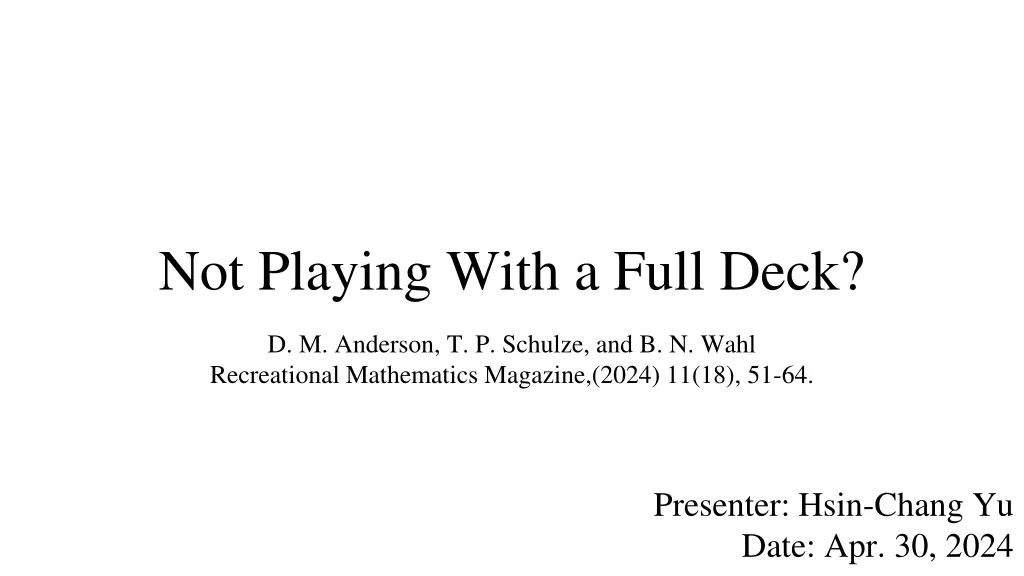
Probability of Two-Pair Hand in 52-Card Deck Analysis
Explore the probability of being dealt a Two-Pair hand from a standard 52-card deck compared to a deck missing the Ace of Spades. Analyze the impact of a missing card on poker outcomes and delve into the calculations behind the probabilities.
Download Presentation

Please find below an Image/Link to download the presentation.
The content on the website is provided AS IS for your information and personal use only. It may not be sold, licensed, or shared on other websites without obtaining consent from the author. If you encounter any issues during the download, it is possible that the publisher has removed the file from their server.
You are allowed to download the files provided on this website for personal or commercial use, subject to the condition that they are used lawfully. All files are the property of their respective owners.
The content on the website is provided AS IS for your information and personal use only. It may not be sold, licensed, or shared on other websites without obtaining consent from the author.
E N D
Presentation Transcript
Not Playing With a Full Deck? D. M. Anderson, T. P. Schulze, and B. N. Wahl Recreational Mathematics Magazine,(2024) 11(18), 51-64. Presenter: Hsin-Chang Yu Date: Apr. 30, 2024
Abstract A standard deck of 52 playing cards has 4 suits: clubs ( ), spades ( ), hearts ( ) and diamonds ( ). Each suit has 13 denominations, or ranks, 2, 3, 4, 5, 6, 7, 8, 9, 10, J (Jack), Q (Queen), K (King) and A (Ace). But sometimes, a card goes missing lost between the couch cushions, clothes-pinned in the bike spokes, filched by the cat, eaten by the dog (see Figure 1), or maybe misplaced in a matching deck. You may find yourself not playing with a full deck. Building a house of cards? No problem. Playing poker? Problem. Or is it? Ask yourself the following question: 2
Abstract What is the probability of being dealt a Two-Pair hand of five cards from a well-shuffled deck when the Ace of Spades is missing from the deck? Specifically, how does it compare to the probability of being dealt a Two-Pair hand from a standard 52-card deck? 3
Abstract What does your probability intuition tell you? On the one hand, with a missing Ace of Spades there are fewer Two-Pair hands. On the other hand, there are also fewer total five-card hands. The ratio of these two numbers defines the probability; which way it goes seems unclear. Let s do the calculation first for the standard 52- card deck and then for the 51-card deck missing the Ace of Spades. 4
Magic Set 10
Magic Set 11
Other Games Texas-Hold'em Heartless Poker Fat Pack Double-Deck Pinochle Deck 14
Wild Cards 15
Some remarks on the Game of Cycles Robbert Fokkink and Jonathan Zandee Recreational Mathematics Magazine,(2024) 11(18), 111 - 118. Presenter: Hsin-Chang Yu Date: Apr. 30, 2024
The Game of Cycles Ryan Alvarado, Maia Averett, Benjamin Gaines, Christopher Jackson, Mary Leah Karker, Malgorzata Aneta Marciniak, Francis Su & Shanise Walker Robbert Fokkink and Jonathan Zandee The American Mathematical Monthly, (2021)128(10), 868-887. Presenter: Hsin-Chang Yu Date: Apr. 30, 2024
Abstract The Game of Cycles, introduced by Su in 2020, is played on a simple connected planar graph together with its bounded cells, and players take turns marking edges with arrows according to a sink- source rule that gives the game a topological flavor. The object of the game is to produce a cycle cell a cell surrounded by arrows all cycling in one direction or to make the last possible move. 18
Abstract We analyze the two-player game for various classes of graphs and determine who has a winning strategy. We also establish a topological property of the game: that a board with every edge marked must have a cycle cell. 19
Definitions Given a planar graph G, we defined the following on G: A planar graph of vertices and edges divides the plane into regions, which we call cells. A graph together with its bounded cells is a game board. A cycle cell is an enclosed area of a graph with nothing inside of it such that every edge enclosing the area is directed the same direction (either clockwise or counterclockwise). A source is a vertex whose edges all point away from it. A sink is a vertex whose edges all point towards it. 20
Definitions A cycle cell is an enclosed area of a graph with nothing inside of it such that every edge enclosing the area is directed the same direction (either clockwise or counterclockwise). A source is a vertex whose edges all point away from it. A sink is a vertex whose edges all point towards it. 21
Rules Two players take turns marking one unmarked edge with an arrow pointing in one direction or the other. Arrows must obey the sink-source rule: players are not allowed to create a sink or a source. Each edge can only admit one arrow. Arrows serve the same function in the game no matter who marks them. Player must make a move if they have a move available to them. 22
Example 23
Thanks 25
